Morgan House, Kalimpong
Morgan House Kalimpong or Morgan House is a mansion of British colonial architecture built by an English jute baron George Morgan in the 1930s on the hill station of Kalimpong, Kalimpong district, West Bengal. Today, the mansion is a hotel managed by West Bengal Tourism Development Corporation (WBTDC). Earlier this property was also known as Singamari Tourist Lodge or Durpin Tourist Lodge.[1]
| Morgan House | |
|---|---|
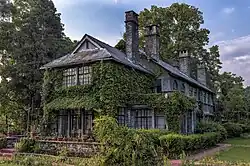 Morgan House, Kalimpong is a colonial British mansion | |
  | |
| Former names | Singamari Tourist Lodge, Durpin Tourist Lodge |
| General information | |
| Status | Converted to Hotel |
| Type | Mansion |
| Architectural style | British colonial architecture |
| Location | Kalimpong, West Bengal |
| Address | Chandraloke, Kalimpong, West Bengal 734301 |
| Town or city | Kalimpong |
| Country | India |
| Coordinates | 27.045380°N 88.460942°E |
| Elevation | 4480.47 feet/1365.65 metre |
| Current tenants | West Bengal Tourism Development Corporation |
| Groundbreaking | 1930 |
| Height | |
| Architectural | British colonial architecture |
| Technical details | |
| Material | Stone, Wood |
| Floor count | 2 |
| Lifts/elevators | 0 |
| Grounds | 16 acres |
| Other information | |
| Number of rooms | 7 |
| Parking | Available |
| Website | |
| https://www.wbtdcl.com/home/lodge_search?Lodge_id=OA&Lodge_destinationName=Mw | |
Location
Morgan House is built on a sixteen-acre estate atop the mountain of Durpindara. It is situated three kilometers off the center of Kalimpong town and has a clear view of the Kangchenjunga mountain range.[2] The mansion and the estate is surrounded by the Kalimpong Cantonment area and overlooks the valleys of Relli, Kapher, Deolo and Labha[3] in various directions.
Morgan House is 75 km from Siliguri, 52 km from Darjeeling and 75 km from Gangtok by road. Nearest railway station is in New Jalpaiguri and nearest airport is in Pakyong.
History
Morgan house is a British colonial mansion built in the early 1930s. The building was to commemorate the wedding of an indigo plantation owner with a jute baron George Morgan.
The property was used as a summer retreat and elaborate parties were hosted. It passed into the hand of trustees after the Morgans died without heir.[2] It was further handed over to government of India post Indian independence. During 1962, after then prime minister Jawahar Lal Nehru was taken ill, plans were made to convert this house into a government rest house.
However, due to sudden demise of Jawahar Lal Nehru,[4][5] this plan was abandoned. In 1965 it was handed to tourism department and in 1975 it was finally handed over to West Bengal Tourism Development Corporation. Since then it is being managed as a boutique hotel and is open to tourists.
Popular culture
Indian actors and celebrities such as Uttam Kumar, Supriya, Kishore Kumar, Amit Kumar, Leena Chandavarkar, Nargis, Sunil Dutt and Om Prakash have stayed in this lodge and their testimonials can be seen framed in the lounge.[6] Actor Utpal Dutt was also a regular visitor.[1] American ambassador in India Chester Bowles stayed here.[2]
This lodge is also considered to be haunted and has been featured in several lists of haunted lodges and hotels.[7][8][9]
Gallery
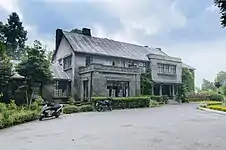 The front of the lodge from the parking area
The front of the lodge from the parking area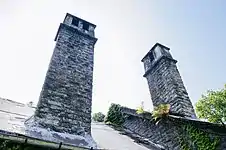 Stone chimneys
Stone chimneys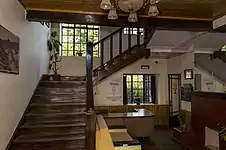 Interior wooden staircase
Interior wooden staircase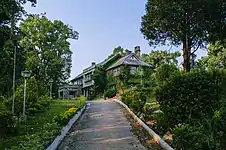 The approach road leading to Morgan House
The approach road leading to Morgan House
 Front corner of Morgan House clad with ivy
Front corner of Morgan House clad with ivy Close-up of rear glass windows of Morgan House
Close-up of rear glass windows of Morgan House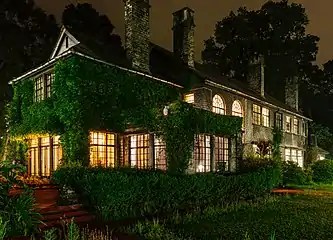 Morgan House at Night from rear lawn
Morgan House at Night from rear lawn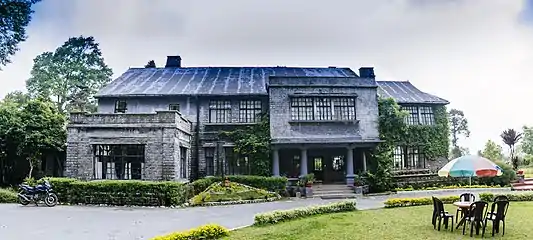 Front view of Morgan House from the lawn
Front view of Morgan House from the lawn
See also
References
- "Next weekend you can be at ... Morgan House". The Telegraph. Retrieved 25 June 2017.
- Subhrajyoti07 (25 June 2017), An old news clipping one can find framed in the lounge, retrieved 25 June 2017
- Subhrajyoti07 (20 May 2017), English: Kalimpong Army Golf Course watershed viewpoint plaq installed by Indian Army, retrieved 25 June 2017
- "Feature". pib.nic.in. Retrieved 22 July 2017.
- "India Mourning Nehru, 74, Dead of a Heart Attack; World Leaders Honor Him". The New York Times. Retrieved 22 July 2017.
- "The Telegraph - North Bengal & Sikkim". www.telegraphindia.com. Archived from the original on 8 October 2014. Retrieved 24 June 2017.
- Kumar, S. "Morgan House, Kalimpong Sightseeing Places – Haunted House in Kalimpong". www.kolkatabengalinfo.com. Retrieved 24 June 2017.
- "Dare to stay at these haunted hotels of India?". Retrieved 24 June 2017.
- "7 Haunted Hotels of India and Spooky Stories Behind Them - Holidify". www.holidify.com. Retrieved 24 June 2017.
Bibliography
- Gordon, Grant (15 March 2012). Cobras in the Rough. Hachette UK. ISBN 978-1-78033-512-4.
- Mitra, Swati (2011). Wild Trail in Bengal: Travel Guide. Goodearth Publications. ISBN 978-93-80262-16-1.
- Mehta, Vinod (2004). 100 holidays in the hills and 100 bonus hideaways. Outlook Pub. (India). ISBN 978-81-901724-6-2.
- The India Travel Planner. Cross Section Publications (P) Limited. 2006.
- Heritage holidays. Outlook Publishing (India). 2004.
- Betts, Vanessa; McCulloch, Victoria (10 February 2014). Indian Himalaya Footprint Handbook: Includes Corbett National Park, Darjeeling, Leh, Sikkim. Footprint Travel Guides. ISBN 978-1-907263-88-0.
- Planet, Lonely; Singh, Sarina; Benanav, Michael; Blasi, Abigail; Clammer, Paul; Elliott, Mark; Harding, Paul; Mahapatra, Anirban; Noble, John; Raub, Kevin (1 September 2015). Lonely Planet India. Lonely Planet. ISBN 978-1-74360-975-0.
- Coxall, Michelle; Greenway, Paul (1 September 1996). Indian Himalaya: a Lonely Planet travel survival kit. Lonely Planet. ISBN 978-0-86442-413-6.
- Desai, Madhavi; Desai, Miki (5 December 2016). The Bungalow in Twentieth-Century India: The Cultural Expression of Changing Ways of Life and Aspirations in the Domestic Architecture of Colonial and Post-colonial Society. Routledge. ISBN 978-1-351-89347-3.